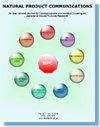Bioinformatic Analysis of Ping-Wei-San Decoction for Pulmonary Malignancy Based on UPLC-QE-Orbitrap-MS Detection
IF 1.4
4区 医学
Q4 CHEMISTRY, MEDICINAL
引用次数: 0
Abstract
BackgroundThe traditional Chinese medicine prescription Ping-Wei-San decoction (PWS) has been used historically in East Asian countries. This study aimed to investigate the ingredients of the decoction and explore its potential role in the adjuvant treatment of pulmonary malignancies.ObjectivesThe primary objective was to analyze the ingredients of PWS and understand its potential in the treatment of pulmonary malignancy.MethodsMedical records of 143 394 patients using PWS over a decade were collected from the Affiliated Hospital of Qingdao University. UPLC-QE-Orbitrap-MS detected 13 chemical components, including 12 known components. Lung adenocarcinoma data were obtained from the TCGA-LUAD dataset, and differential genes were screened using R studio. The EVENN website and the STRING database were used to identify drug action and disease targets.SettingThe study was conducted at the Affiliated Hospital of Qingdao University.ParticipantsThe study included 3147 patients with “pulmonary malignancies.”InterventionPWS was used as an adjuvant treatment.ResultsNetwork analysis revealed 10 core targets (CCNA2, CHEK1, TOP2A, CDK1, CCNB1, CCNB2, AURKA, AURKB, KIF11, and MELK) for the treatment of lung adenocarcinoma and associated pathways.ConclusionPWS may offer multifunctional efficacy in the treatment of pulmonary malignancies based on constituent analysis. Further research and clinical trials are needed to explore its potential.基于 UPLC-QE-Orbitrap-MS 检测的平威散煎剂治疗肺部恶性肿瘤的生物信息学分析
背景传统中药处方平胃散煎剂(PWS)在东亚国家一直沿用至今。方法从青岛大学附属医院收集了143 394名患者十年来使用平威散的病历资料,通过UPLC-QE-Orbitrap-MS检测了13种化学成分,包括12种已知成分。UPLC-QE-Orbitrap-MS检测了13种化学成分,包括12种已知成分。肺腺癌数据来自TCGA-LUAD数据集,并使用R工作室筛选了差异基因。研究在青岛大学附属医院进行,纳入了3147名 "肺部恶性肿瘤 "患者。结果网络分析发现了治疗肺腺癌的10个核心靶点(CCNA2、CHEK1、TOP2A、CDK1、CCNB1、CCNB2、AURKA、AURKB、KIF11和MELK)及相关通路。需要进一步的研究和临床试验来挖掘其潜力。
本文章由计算机程序翻译,如有差异,请以英文原文为准。
求助全文
约1分钟内获得全文
求助全文
来源期刊

Natural Product Communications
工程技术-食品科技
CiteScore
3.10
自引率
11.10%
发文量
254
审稿时长
2.7 months
期刊介绍:
Natural Product Communications is a peer reviewed, open access journal studying all aspects of natural products, including isolation, characterization, spectroscopic properties, biological activities, synthesis, structure-activity, biotransformation, biosynthesis, tissue culture and fermentation. It covers the full breadth of chemistry, biochemistry, biotechnology, pharmacology, and chemical ecology of natural products.
Natural Product Communications is a peer reviewed, open access journal studying all aspects of natural products, including isolation, characterization, spectroscopic properties, biological activities, synthesis, structure-activity, biotransformation, biosynthesis, tissue culture and fermentation. It covers the full breadth of chemistry, biochemistry, biotechnology, pharmacology, and chemical ecology of natural products.
Natural Product Communications is a peer reviewed, open access journal studying all aspects of natural products, including isolation, characterization, spectroscopic properties, biological activities, synthesis, structure-activity, biotransformation, biosynthesis, tissue culture and fermentation. It covers the full breadth of chemistry, biochemistry, biotechnology, pharmacology, and chemical ecology of natural products.
 求助内容:
求助内容: 应助结果提醒方式:
应助结果提醒方式:


